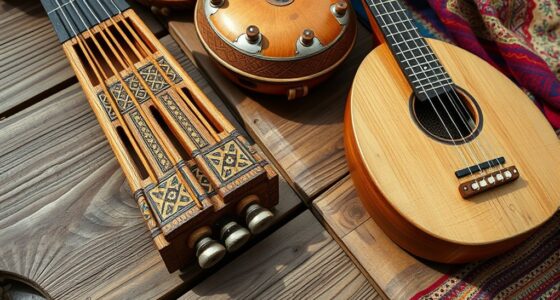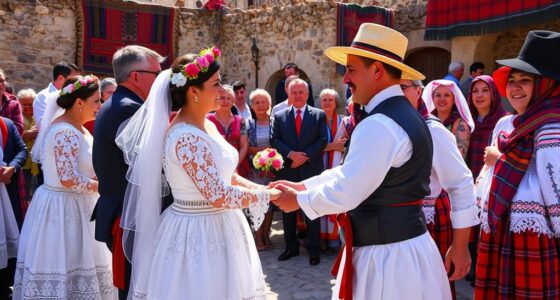Sardinia’s language variants are truly unique, comprising four main groups: Logudorese, Campidanese, Gallurese, and Sassarese. Each reflects different historical influences, from Latin and Corsican to Catalan and Spanish. Logudorese is highly conservative, while Campidanese shows more Italian contact. Northern dialects blend Sardinian with Corsican roots. If you explore further, you’ll uncover the rich cultural heritage and ongoing efforts to preserve these fascinating linguistic traditions.
Key Takeaways
- Sardinia hosts four main dialect groups: Logudorese, Campidanese, Gallurese, and Sassarese, each with distinct linguistic features.
- Logudorese is highly conservative, preserving Latin vocabulary, declensions, complex verb forms, and archaic phonetics.
- Gallurese and Sassarese show Corsican influence, with unique phonetics and vocabulary, acting as regional linguistic bridges.
- Campidanese features Latin roots and Spanish loanwords due to historical contact, with a melodic speech pattern.
- External influences include Catalan, Spanish, Tuscan, Ligurian, and traces of Byzantine Greek and Arabic, enriching Sardinian linguistic diversity.
The Four Main Sardinian Language Groups
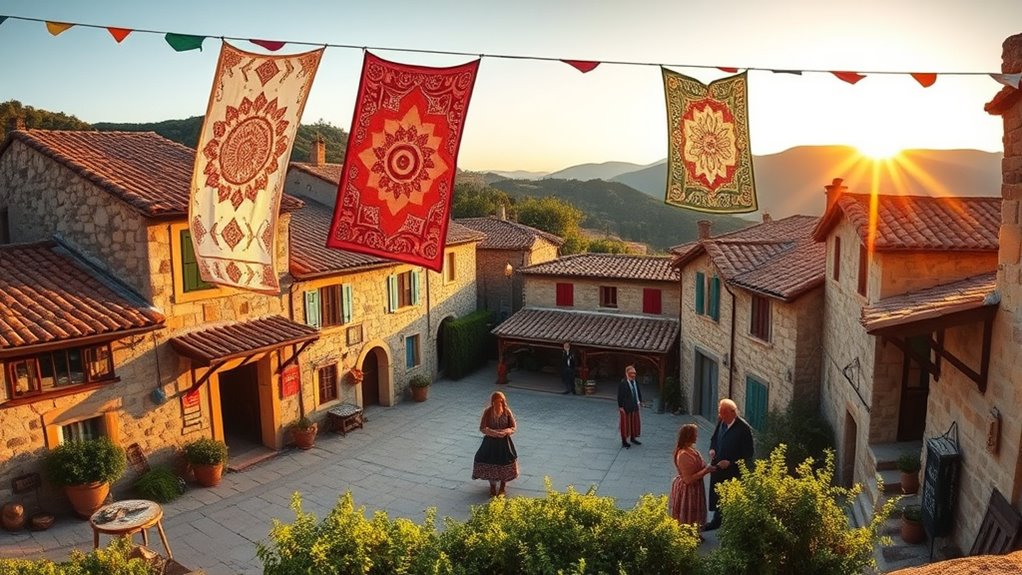
Have you ever wondered how Sardinian language varies across the island? Sardinia’s linguistic landscape is divided into four main groups. First, Logudorese Sardinian, spoken in central and northern Sardinia, is highly conservative and preserves many Latin features. It shares about 73% lexical similarity with Campidanese but differs from Italian. Next, Gallurese Sardinian, in the northeast, is influenced by Corsican and Tuscan, often seen as a distinct language due to its differences. Then, Sassarese Sardinian, in the northwest, mixes elements from Tuscan, Ligurian, Corsican, and Catalan, making it quite unique. Each group has its dialects, and while some mutual understanding exists, notable differences can limit comprehension across regions. These variations highlight Sardinia’s rich and diverse linguistic heritage, which reflects its complex history of external influences. Additionally, the linguistic diversity in Sardinia has been shaped by centuries of different civilizations and cultural exchanges.
Characteristics of Campidanese Sardinian
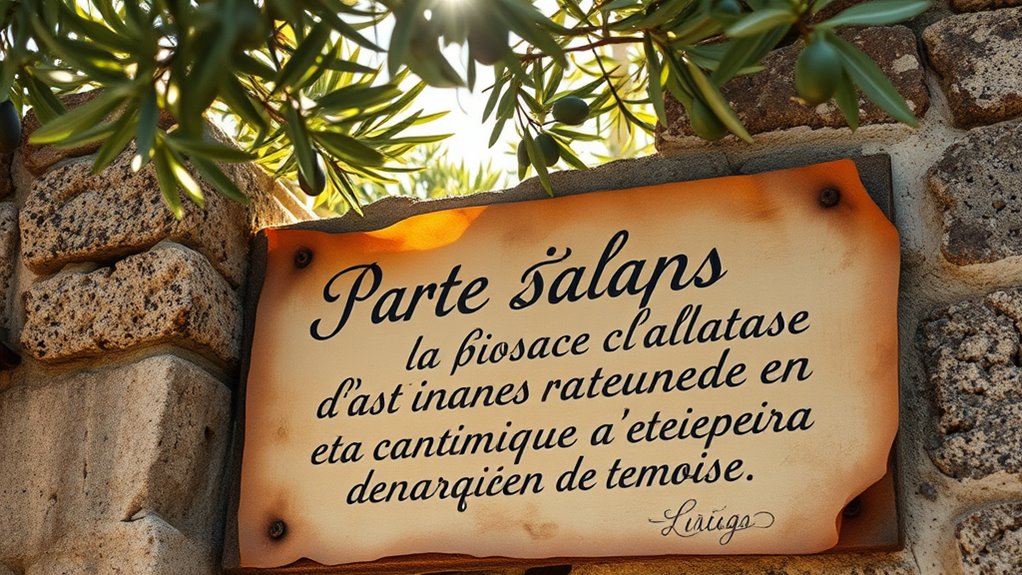
You’ll notice that Campidanese Sardinian features various dialectal differences across its regions, shaped by local history and contact with other languages. Its phonological traits include a softer pronunciation and preservation of Latin sounds, setting it apart from other Sardinian varieties. These characteristics reflect its unique blend of influences and its role as a key written standard for the language. Furthermore, the dialect’s vocabulary incorporates numerous loanwords from Spanish, highlighting the historical Spanish rule in the region. Its linguistic diversity is a testament to the region’s complex cultural interactions over time.
Dialectal Variations
Campidanese Sardinian exhibits distinct dialectal features that set it apart within the broader Sardinian language landscape. Spoken mainly in central-southern Sardinia, it reflects a rich history influenced by Latin, Catalan, Spanish, and Italian. You’ll notice unique vocabulary that conserves archaic Latin words and incorporates loanwords from former rulers. Morphologically, the dialect preserves Latin-like articles and verb forms, with adjectives agreeing in gender and number. Its syntax follows a straightforward subject-verb-object order, similar to Italian and English. Regional variations within Campidanese often stem from historical centers and urban influences, creating subtle differences in pronunciation and word choice. Despite Italian dominance, the dialect remains essential in communities, maintaining cultural identity through oral traditions and written forms. It is also considered one of the most conservative Sardinian dialects, which contributes to its preservation of older linguistic features. Additionally, efforts to document and promote the dialect help sustain its linguistic heritage for future generations.
Phonological Traits
Campidanese Sardinian displays distinct phonological characteristics that set it apart within the Sardinian language group. You’ll notice unique patterns like how stop consonants behave differently depending on their position—staying as stops initially and post-consonantally but changing intervocalically. Lenition and gemination add complexity, affecting all consonants and interacting with length and voicing. The vowel system includes seven vowels, with [ɛ] and [ɔ] raised to [e] and [o] when followed by high vowels, but in final syllables, [ɛ ɔ] are raised to [i u]. Additionally, the distinctive features of the dialect influence its melodic pattern and speech rhythm. The rhotic system features a single /r/. Intonation emphasizes initial syllables, and mid tones mark non-finality, shaping the rhythm of speech. The table below highlights these traits:
| Phonological Trait | Effect/Example |
|---|---|
| Stop behavior | Changes intervocalically |
| Vowel raising | [ɛ ɔ] raised to [i u] in final syllables |
| Intonation patterns | Emphasizes initial words |
Features of Logudorese Sardinian
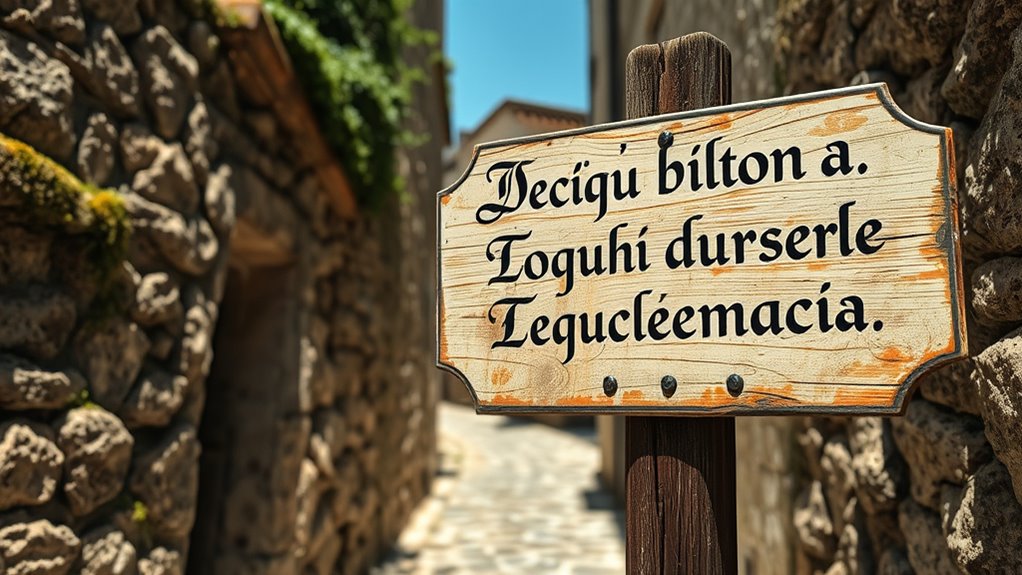
You’ll notice that Logudorese Sardinian preserves many Latin features, making it more conservative than other Romance dialects. Its phonetic system retains Latin vowel qualities and consonant sounds with less lenition, giving it a distinct sound. Dialectally, it shows clear differences from Campidanese Sardinian, reflecting regional variations rooted in historical and linguistic development. This conservatism also influences its grammar and vocabulary, setting it apart from other Sardinian variants and contributing to its unique linguistic identity.
Latin Preservation Features
Logudorese Sardinian stands out among Romance languages for its remarkable preservation of Latin features. You’ll notice it retains much of Latin’s vocabulary, especially words related to culture and nature, like “nuraghe.” Its grammar reflects Latin roots, with declension systems and complex verb forms, including a rich subjunctive. Sometimes, you’ll see a subject-object-verb order, reminiscent of Latin flexibility. Morphologically, Latin endings and prefixes remain clear, showing a slow evolution. Phonologically, the language preserves Latin’s hard “c” sounds and vowel qualities, with limited palatalization. The continued use of old texts from the 15th century highlights its conservative nature. Moreover, the historical texts underscore its status as a conservative linguistic enclave.
Phonetic Characteristics
The phonetic features of Logudorese Sardinian reveal a conservative sound system closely aligned with Latin origins. You’ll notice that:
- It retains Latin plosives /k/ and /ɡ/ before front vowels /e/ and /i/ without palatalization, unlike most Romance languages.
- Guttural sounds are present, giving the language a distinctive, archaic quality.
- Borrowings introduce affricates /t͡ʃ/ and /d͡ʒ/, though some dialects, like Nuorese, have /t͡s/ and /d͡z/ instead.
- Consonants are articulated conservatively, with less palatalization and lenition, preserving older Latin-like pronunciations.
- Its phonetic conservatism makes Logudorese an important subject for linguistic studies of Latin phonetics in Romance languages, especially because of its archaisms that are rarely found in other dialects.
Dialectal Variations
What sets Logudorese Sardinian apart from other dialects is its remarkable conservatism, which preserves many archaic features rooted in Latin and local substratum influences. You’ll notice its complex morphology, such as Latin-like declensions and verb conjugations close to the original language. The dialect often uses the subjunctive mood to express nuance, and in some cases, employs a subject-object-verb order, uncommon in Romance languages. Its vocabulary retains many Latin-derived terms and local substratum words from the Nuragic period, like “nura.” Although influenced by Catalan and Spanish, Logudorese maintains a distinct, prestigious identity, especially in literature. Its syntactic structures and lexical conservatism highlight a deep-rooted historical continuity, making it one of the most authentic and well-preserved Sardinian variants. Additionally, this dialect’s preservation of archaic linguistic features underscores its importance for linguistic and cultural heritage.
Northern Sardinian Dialects: Gallurese and Sassarese
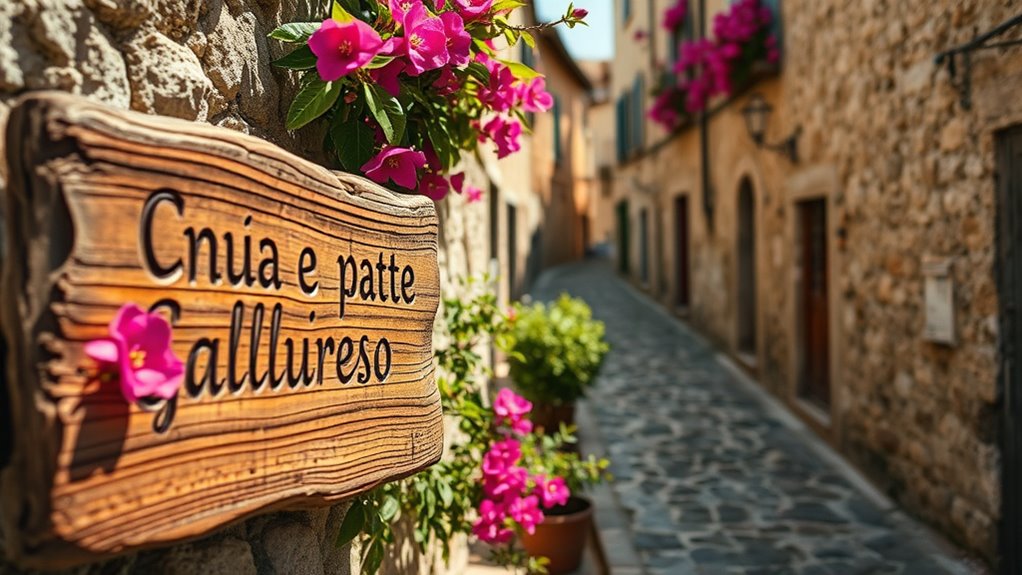
Northern Sardinian dialects like Gallurese and Sassarese stand out for their unique Corsican roots rather than direct Sardinian origins. You’ll notice that:
- Gallurese shares phonetic features like ‘ghj’ and ‘chj’ sounds, resembling Corsican more than Italian or Sardinian.
- Its vocabulary is deeply Corsican, with some words exclusive to Gallurese, highlighting its distinct identity.
- Verb conjugations show complexity, reflecting Corsican influence, and diverge from standard Italian patterns.
- Sassarese, influenced by Corsican, Tuscan, and Sardinian, acts as a conduit dialect, rich in history and regional pride.
- Linguistic features such as pronunciation and grammatical structures further emphasize its Corsican heritage.
These dialects, shaped by centuries of interaction, remain essential cultural symbols in northern Sardinia, despite modern challenges.
The Catalan Heritage of Alghero

Alghero’s linguistic landscape reveals a deep-rooted Catalan heritage that dates back to the 14th century. In 1372, Catalan colonists repopulated the city after Sardinian populations were expelled during the Crown of Aragon period. For centuries, Catalan was the dominant language, later replaced officially by Spanish and then Italian. Today, between 20,000 and 30,000 people worldwide speak Algherese Catalan, mainly in Alghero and nearby areas. About 24% of locals identify it as their mother tongue, with 18.5% habitually speaking it. Despite pressures from Italian and Sardinian, the dialect retains distinctive phonetic features, vocabulary, and cultural significance. It’s a symbol of local identity, celebrated through festivals, architecture, and arts, reinforcing Alghero’s unique Catalan roots. The dialect’s survival is supported by community efforts and linguistic preservation initiatives and ongoing cultural programs.
Variations and Mutual Intelligibility Across Sardinia
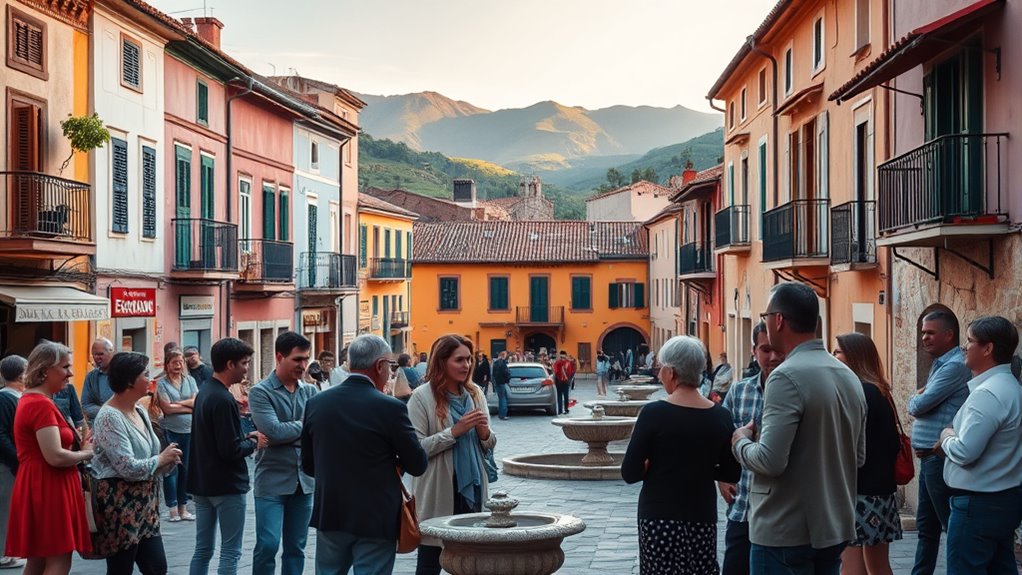
Sardinian’s regional dialects exhibit notable variations that influence how speakers understand each other across the island. You’ll notice significant differences between the macro-dialects:
Sardinian dialects vary greatly, impacting mutual understanding across the island’s macro-dialects.
- Logudorese and Campidanese differ greatly, with Logudorese being more conservative and harder to understand without familiarity.
- Sassarese and Gallurese have mixed Sardinian-Italian features, making them partly intelligible but distinct.
- Communication between Logudorese and Campidanese often requires adaptation due to phonological and lexical gaps.
- Nuorese shares similarities with Logudorese but has unique traits, limiting comprehension by Campidanese speakers.
Mutual intelligibility is often asymmetrical, with Campidanese speakers understanding Logudorese better than vice versa, mainly because of exposure and lexical borrowings. Geographic and historical factors shape these variations.
External Influences Shaping Sardinian Languages
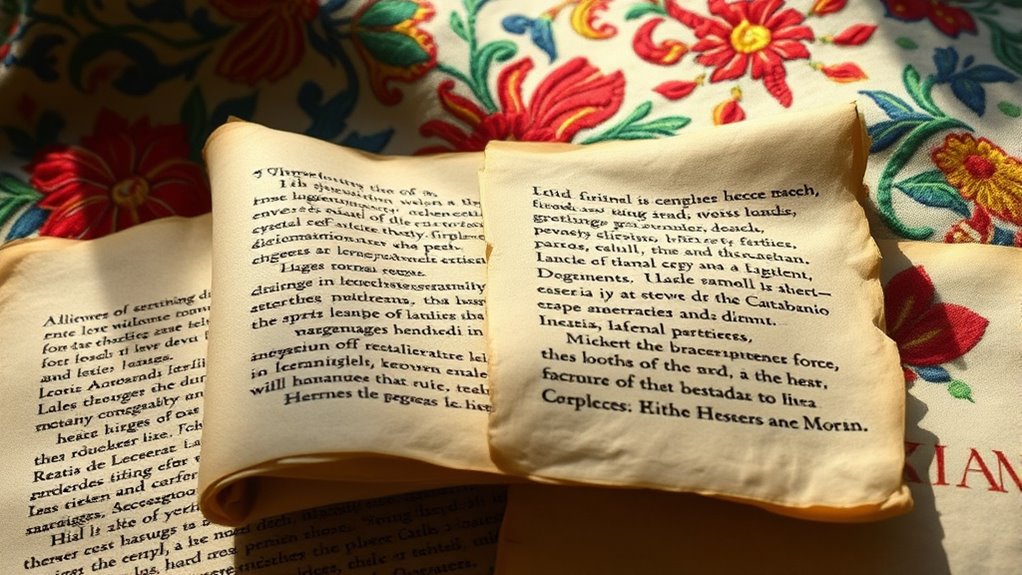
External influences have played a significant role in shaping the diverse variants of Sardinian languages, reflecting centuries of contact with other cultures. Spanish and Catalan rule left a strong mark, especially in the Campidanese dialect, with loanwords and phonetic traits like words ending in “-u,” mirroring Spanish pronunciation. Catalan was used officially into the 18th century, influencing legal and administrative language. Italian and Tuscan influences grew from the Middle Ages, especially under Savoyard rule, blending vocabulary and syntax and leading to mixed dialects like Sassarese and Gallurese. Northern Sardinian dialects, such as Gallurese and Sassarese, show Corsican and Ligurian influences due to proximity and migration. Older traces of Byzantine Greek and Arabic also remain, mainly in religious terms and place names, illustrating Sardinia’s role as a Mediterranean crossroads. Additionally, linguistic heritage preservation efforts help safeguard these diverse dialects and their historical roots.
Preservation and Decline of Sardinian Dialects

Since the 1960s, Sardinian dialects have faced a rapid decline, primarily due to the breakdown of intergenerational transmission. You’ll notice fewer native speakers, especially in cities like Cagliari, where Sardinian is rarely passed to children. The language’s future is uncertain, with many younger people only partial users or learners. To understand the decline:
- UNESCO classifies Sardinian as “definitely endangered,” citing broken transmission chains.
- Regional laws, like Law 482/1999, recognize Sardinian but struggle against Italian dominance.
- Urban dialects, such as Campidanese, show significant speaker loss, with only around 31% demonstrating fluency.
- Rural dialects remain somewhat stronger but are also declining due to sociolinguistic shifts and cultural assimilation.
- The integration of digital technology and automation in language preservation efforts could help slow this decline. digital technology can provide innovative tools to support language learning and documentation for endangered dialects.
The result is a fragile linguistic landscape, at risk of fading entirely if preservation efforts falter.
The Role of Sardinian Languages in Contemporary Culture
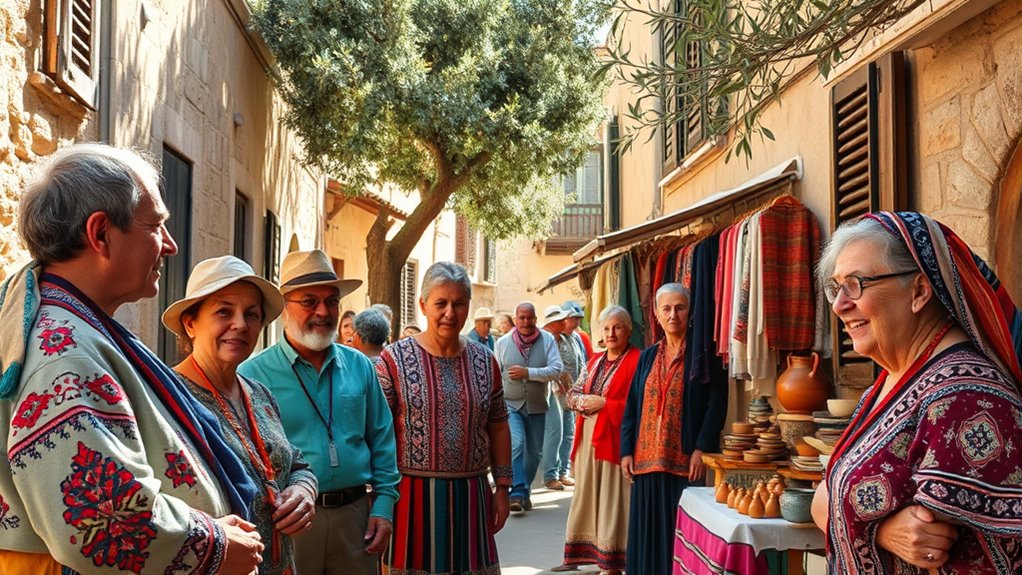
Despite challenges, Sardinian languages continue to play an essential role in contemporary culture, serving as symbols of regional identity and pride. You’ll find Sardinian in education, protected by laws that promote its use in public documents and media, though Italian dominates schools and broadcasts. The regional government introduced Limba Sarda Comuna to unify dialects, but many locals remain skeptical. Cultural expressions like poetry, music, and festivals keep Sardinian alive, especially in rural areas where dialects are stronger. Younger generations often have limited fluency, but pride persists, and many claim some knowledge. Social media and cultural initiatives help bridge tradition and modern identity. Overall, Sardinian languages remain crucial in fostering community cohesion and cultural expression, despite societal and institutional hurdles.
Frequently Asked Questions
How Do Sardinian Dialects Influence Local Sardinian Identity?
You see how dialects shape Sardinian identity by reinforcing local pride and cultural ties. When you speak Logudorese, Campidanese, Sassarese, or Gallurese, you’re connecting to a specific history and community. These dialects mark territorial belonging, preserve traditions, and foster a sense of continuity. Despite outside influences, maintaining your dialect helps you stay rooted in your heritage, expressing unique regional identities and strengthening community bonds across the island.
Are There Efforts to Revive Older Sardinian Language Variants?
Imagine a gardener tending ancient seeds buried deep in the soil—that’s what efforts to revive older Sardinian language variants feel like. You’ll find initiatives like documentation platforms and standard orthography, which act as nurturing tools. Schools, media, and festivals are like sunlight and water, helping these old dialects flourish again. These collective efforts aim to preserve Sardinia’s linguistic roots, ensuring these cherished words continue to grow for future generations.
What Are the Challenges in Teaching Sardinian Languages Today?
You face many challenges when teaching Sardinian languages today. The language’s decline in younger generations, limited educational programs, and scarce resources make it difficult to keep it alive. Italian dominates schools and media, reducing exposure and motivation. Regional dialect differences complicate standardization, and there’s little institutional support or trained teachers. Technology gaps and rural school access issues further hinder efforts to effectively teach and promote Sardinian.
How Does Sardinian Compare to Other Romance Languages Historically?
When comparing Sardinian to other Romance languages historically, you’ll notice it’s more conservative, preserving many archaic Latin features. Unlike Italian, which evolved under Tuscan influence, Sardinian stayed closer to Latin due to its geographical isolation. Throughout history, foreign rulers like Spain and Italy shaped its vocabulary and pronunciation, but it remained distinct. This deep Latin connection makes Sardinian unique among Romance languages, offering a rare glimpse into early Latin evolution.
Are Sardinian Dialects Mutually Understandable by Speakers From Different Regions?
Imagine trying to understand a song sung in different regional dialects—like Sardinian’s dialects. You find that Logudorese and Campidanese are mostly understandable because they share roots, but dialects like Gallurese or Sassarese can feel like foreign tunes due to Corsican and Tuscan influences. Regional differences, local slang, and historical influences dance around, making mutual understanding a beautiful, yet complex, mosaic across Sardinia’s diverse linguistic landscape.
Conclusion
You can see that Sardinian’s diverse language variants reflect a rich cultural tapestry. Many believe the dialects’ uniqueness helps preserve regional identities, making them essential to Sardinia’s heritage. Embracing these languages isn’t just about tradition; it’s about safeguarding a linguistic treasure that, according to linguistic experts, could vanish if not actively preserved. So, supporting efforts to maintain Sardinian dialects ensures this beautiful linguistic diversity continues to thrive for generations to come.


